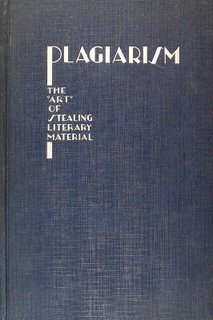 so it's been said that "there are a million stories in the naked city" (and just so there's no question of it--I Am Not Claiming That as My Original Phrase.) and i've never been entirely convinced of that--i think there may be million ways to tell a handful of stories all surrounding basic desires; but there are very few desires when it comes right down to it (Language Log may make a much more eloquent statement than i can.) The art comes in the telling (and in the perspective of the artist--there are those who argue--sometimes me among them that artists have to be just a little crazy in some way or another to have that perspective but that's another subject entirely...)
so it's been said that "there are a million stories in the naked city" (and just so there's no question of it--I Am Not Claiming That as My Original Phrase.) and i've never been entirely convinced of that--i think there may be million ways to tell a handful of stories all surrounding basic desires; but there are very few desires when it comes right down to it (Language Log may make a much more eloquent statement than i can.) The art comes in the telling (and in the perspective of the artist--there are those who argue--sometimes me among them that artists have to be just a little crazy in some way or another to have that perspective but that's another subject entirely...) And that brings us to the, oh so many questions, revolving around How Opal Mehta Got Kissed, Got Wild, and Got a Life brouhaha, a book that didn't catch my interest much with the first review i read, and still doesn't, although what is going on with it now sure does. Now i've always been against plagiarism, and it seems to be an issue plaguing modern day society. According to the Center for Academic Integrity at Duke University up to 40% of college students admit to "cut & paste" plagiarism. Now supposedly Kaavya Viswanathan wrote at least 40 passages that "contain identical language and/or common scene or dialogue structure" with Megan McCafferty's Sloppy Firsts and Second Helpings. I've looked at a few of these and it does seem a little too close for comfort--Kaavya's excuse? She loved McCaferty's work, and must have internalized it.
But there are a few other issues that popped up (first how does a senior in high school get a $500,000 advance based on a writing sample and can i sign up somewhere--i promise not to plagiarize--in fact i'll settle for $100,000...but back to the topic at hand) like book packagers. Apparently Kaavya's "college application coach" heard she was a writer and got her an agent at William Morris. The agent got her a deal with a "packager" (Alloy). Book packagers often give writers plots, characters, etc., and have them fill in the details. Reportedly Kaavya sent them chapters (of what was apparently a much darker tale at one point--one that sounds a little more appealing to me) and they "helped" her edit--exactly how much writing Alloy did is becoming less and less clear as time goes by (as for editing that is definitely a lost art have you tried to read any published works lately???) --In fact, in this particular case, the same editor, Claudia Gabel, is thanked on the acknowledgments pages of both Ms. McCafferty's books and Ms. Viswanathan's How Opal Mehta Got Kissed, Got Wild, and Got a Life. Ms. Gabel had been an editorial assistant at Crown Publishing Group, then moved to Alloy, where she helped develop the idea for Ms. Viswanathan's book. So, the same woman who helped along on McCafferty's books also worked on Viswanathan's book? And she didn't notice any similarities?? Who is at more fault here the seventeen-year-old girl or the experienced editor? And who actually did the bulk of the plagiarizing? Will we ever really know?
And now further scrutiny, and so very much scrutiny, seems to be revealing "borrowing" from other novels by Cabot, Kinsella, and Rushdie--now this seems to me to be carrying things a bit too far. These "similarities" mostly seem to be descriptions of things people might say, common expressions--or, in the case of the Rushdie book, rhyming roadsides which are common in India. I'm sure if we look hard enough we will find the influences others in every artist's work because we cannot help but be the sum of all that has gone before; we can on ly hope for some originality and profundity.
ly hope for some originality and profundity.
 ly hope for some originality and profundity.
ly hope for some originality and profundity.Anyone remember Milli Vanilli?
No comments:
Post a Comment